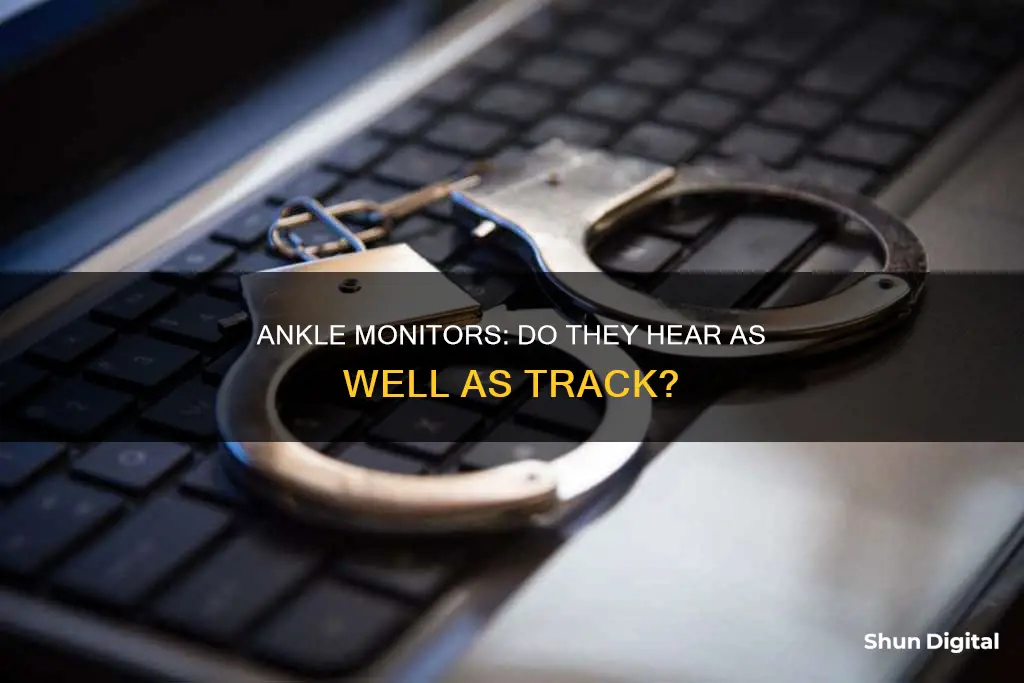
Electronic tagging or ankle monitors are used as a form of surveillance to monitor the behaviour of suspects or offenders. These are often used for house arrest, alcohol monitoring, or on bail pending a trial. In some cases, ankle monitors are also used to monitor high school students with poor attendance. While ankle monitors are often believed to be unable to get wet, they are in fact waterproof, though the signal may be weaker or blocked completely when submerged. Ankle monitors are also capable of more than just tracking someone's movements. For example, Secure Continuous Remote Alcohol Monitors (SCRAM) can test sweat and detect alcohol levels in the body.
Some GPS ankle monitors are also capable of audio recording, functioning like cell phones. This has raised concerns among civil libertarians and prisoner advocacy groups, who argue that this infringes on the right to privacy and may allow private conversations with attorneys to be recorded. However, proponents of this technology argue that it enhances accountability and the ability of authorities to contact the wearer in emergencies.
| Characteristics | Values |
|---|---|
| Purpose | Surveillance, monitoring the behavior of suspects or offenders |
| Users | People on bail or probation, parolees, sex offenders, pre-trial defendants, high school students, etc. |
| Features | Waterproof, GPS, alcohol monitoring, voice activation, panic button |
| Cost | $5-15 per day plus a setup fee as high as $200 |
| Drawbacks | Can be removed with a strong pair of scissors, may infringe on privacy and human rights |
What You'll Learn

GPS ankle monitors can record conversations without the wearer's knowledge
Some GPS ankle monitors have been found to be capable of recording conversations without the wearer's knowledge or consent. This was first discovered in Puerto Rico when a defense attorney asked a client about the GPS ankle bracelet he was wearing as a condition of his bail. The client stated that "They speak to me through that thing".
During a subsequent court hearing, a technician for SecureAlert, the company that manufactures the monitors, revealed that the devices can be turned on at will and without warning, allowing conversations to be recorded without the wearer's knowledge. This has shocked civil libertarians and prisoner advocacy groups, who argue that this infringes on the right to privacy and could potentially violate the Fourth Amendment, the Federal Wiretap Act, and various state constitutions.
Proponents of the technology counter that it enhances accountability and the ability of authorities to contact and monitor the wearer in emergencies. They also point to the real-time monitoring capabilities of the devices as an essential deterrent, as they allow law enforcement to be notified immediately if the wearer violates any movement restrictions.
While the use of GPS ankle monitors can be a more effective alternative to incarceration, the potential for surreptitious recording of conversations highlights important privacy concerns that need to be addressed by lawmakers and the companies involved.
Best Monitor Size for Dell Inspiron 5559
You may want to see also

The wearer can press a panic button to call for help
Ankle monitors are often used as an alternative to prison sentences for first-time and non-violent offenders. They are also used for house arrest, alcohol monitoring, or bail before a trial. Ankle monitors are part of a complex system for monitoring the behaviour of suspects or offenders. The system works only when the person wearing the monitor complies.
Ankle monitors are equipped with a panic button that the wearer can press to call for help. Pressing the panic button initiates a call to a support technician. The wearer can also be contacted by the monitoring authorities, and the connection can be established without the wearer's knowledge.
The panic button can be a useful feature for those who are wearing the ankle monitor as a condition of bail or probation. For example, it can be used by someone on house arrest who is facing an emergency or feeling vulnerable. It can also be used by a victim of stalking or domestic violence who is banned from approaching their former partner or their children's school.
However, it is important to note that the panic button feature does not physically restrain the wearer from leaving a certain area or prevent them from re-offending. The effectiveness of ankle monitors in reducing crime has been questioned, as they can be easily removed, and a determined offender can still commit a crime.
The use of ankle monitors has sparked debates and raised concerns about privacy and human rights. While proponents argue that it enhances accountability and the ability of authorities to contact the wearer in emergencies, civil libertarians and prisoner advocacy groups have expressed outrage over the discovery that some monitors can record conversations without the wearer's knowledge or consent.
Removing Base Monitors P215H: A Step-by-Step Guide
You may want to see also

Ankle monitors are waterproof
Ankle monitors are a cost-effective alternative to prison, saving over $14,000 per year, per person, in incarceration costs. They are often used for house arrest, alcohol monitoring, or for those on bail. They are also used in healthcare settings and in immigration contexts.
Ankle monitors are also used to monitor alcohol consumption. Secure Continuous Remote Alcohol Monitors (SCRAM) can test your sweat and detect your alcohol consumption.
Some ankle monitors have microphones and can record conversations without the wearer's consent. This has caused controversy, with civil libertarians and prisoner advocacy groups expressing outrage.
Ankle monitors are just one part of the electronic tagging system. Tags can be fitted to the ankle or wrist and are used in combination with the Global Positioning System (GPS) to monitor an individual's location. This technology was first developed in the 1960s by researchers at Harvard University, who created a portable electronic tag called the "behaviour transmitter-reinforcer." The device was designed to transmit positive reinforcement messages to young offenders to assist in their rehabilitation.
Today, electronic monitoring is used in many countries, including the US, UK, Australia, New Zealand, Brazil, and South Africa. While it is often seen as a more effective punitive measure than fines or community service, critics argue that it infringes on privacy and human rights.
Best Places to Buy AOC LED Monitors
You may want to see also

They can be used to monitor alcohol consumption
Ankle monitors are regularly used as an alternative to prison or jail time, often during probation or for pre-trial conditions. They are typically GPS-run and are used to monitor the location of the wearer. However, they can also be used to monitor alcohol consumption for repeat offenders of drinking-related crimes, such as DUIs.
One such ankle monitor is the SCRAM CAM® bracelet, which provides 24/7 transdermal alcohol testing. By automatically sampling the wearer's perspiration every 30 minutes, the SCRAM CAM bracelet helps to eliminate testing gaps and encourages accountability. This continuous alcohol monitoring has been proven to support long-term behaviour change and is an effective tool for treating alcohol dependence or addiction.
The SCRAM CAM bracelet works by testing the wearer's insensible perspiration, which is the small amount of alcohol that is excreted through the skin after consumption. This skin-level measurement is known as transdermal alcohol concentration. The device will conduct tests regardless of the wearer's activity or level of perspiration.
The SCRAM CAM system utilises a wireless base station to transmit testing data to the SCRAM Optix™ online monitoring software. If an alert is generated, a team of trained analysts reviews the data and surfaces any violations to the supervising authority. This automated testing eliminates the opportunity for the wearer to drink around test schedules and provides courts with confidence in the test results.
In addition to monitoring alcohol consumption, SCRAM CAM bracelets also feature industry-leading anti-tamper technology. The devices are equipped with a robust tamper clip and an intuitive installation process, ensuring that the bracelet is securely fastened to the wearer's ankle. This provides confidence and reassurance for true continuous monitoring.
The use of ankle monitors with alcohol-monitoring capabilities, such as the SCRAM CAM bracelet, offers a valuable tool for courts to hold offenders accountable and encourage compliance with court-ordered restrictions. By supporting long-term behaviour change, these devices can help reduce the risk of re-offence and promote sobriety among high-risk individuals.
Disabling Your HP LCD Monitor: A Step-by-Step Guide
You may want to see also

They are cheaper than prison
Ankle monitors are often considered a cheaper alternative to prison. In the US, the cost of incarcerating a person is over $20,000 a year, while house arrest with an ankle monitor costs about $6,000 per year.
In England and Wales, the use of ankle monitors or electronic tagging has increased sharply, from 9,000 cases in 1999-2000 to 53,000 in 2004-05. During this period, the Home Office spent £102.3 million on the electronic monitoring of curfews, which is still considered cheaper than custody.
However, it is important to note that the cost of ankle monitors is often passed on to the wearer, who has to pay a setup fee and a daily use fee. These fees can be a significant financial burden, especially for those who are already struggling financially after incarceration. In some cases, the daily fee for the monitor may be more than the person's monthly rent.
While ankle monitors are often seen as a more affordable option than prison, there are concerns about the impact on civil liberties and the potential for unfair financial penalties. The devices track an individual's movements and can record conversations without their knowledge or consent, raising questions about privacy and constitutional rights.
Additionally, the rules for wearing a monitor can be restrictive, and any violations can result in further legal consequences. For example, tampering with or removing the device can result in criminal charges and additional jail time.
Overall, while ankle monitors may be cheaper than prison from a financial perspective, there are other costs and implications associated with their use that need to be carefully considered.
Best Places to Buy PRGR Launch Monitors
You may want to see also
Frequently asked questions
It is unclear which specific ankle monitors have microphones, but it has been revealed that some GPS ankle monitors have audio recording capabilities. This was discovered when a defense attorney in Puerto Rico asked a client about the GPS ankle bracelet he was wearing as a condition of his bail.
There are concerns about the privacy and constitutional rights of individuals wearing ankle monitors with audio recording capabilities. Civil libertarians and prisoner advocacy groups have expressed outrage, arguing that the ability to record conversations without the wearer's knowledge or consent infringes on the right to privacy and could potentially violate the Fourth Amendment and the Federal Wiretap Act.
Proponents of ankle monitors with microphones argue that they enhance accountability and improve the ability of authorities to contact and monitor the wearer. Additionally, real-time monitoring can serve as a deterrent and allow law enforcement to be notified if the wearer violates any movement restrictions.







